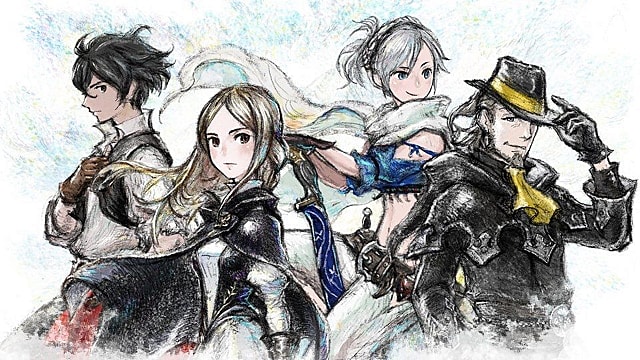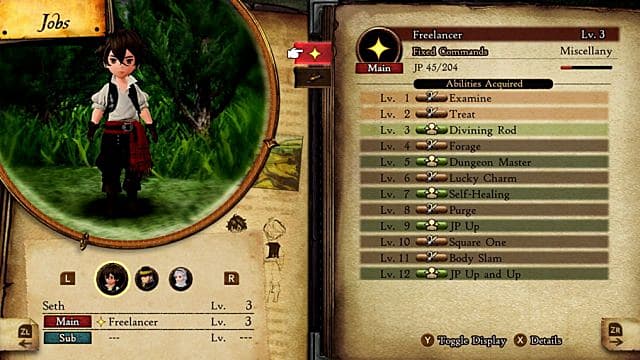In this Bravely Default 2 gameplay tips guide, I’ll touch on some of these subjects, as well as other important ones, to give you everything you need to get started, whether you’ve played the previous games or fresh to the series.
Is Forage Worth It?
Forage is one of the first skills you’ll unlock as a Freelancer. It’s worth using for a little while and often nets you some EXP or JP orbs, plus some other handy items.
Cutting grass beats Forage nearly every time, however, because you’ll frequently get large amounts of money, restorative items, and even some good equipment for cutting grass. In chapter one, for example, I found an expensive axe for my Vanguard before even making it to Savalon.
What are Collectable Resources For?
Bravely Default 2’s collectable resources — those random monster parts you often get from battles — are primarily for selling. Some quests require specific resources periodically. They’re easy enough to find, though, so instead of hoarding, do your wallet a favor and sell, sell, sell.
Boat Exploration Not Working?
Your first sidequest in Bravely Default 2 unlocks boat exploration, the sequel’s version of town building from the original. It’s impossible to miss the quest, and once you’re finished, the old lady sets up shop in whatever city you’re in at the time.
You’ll gain rewards from boat exploration while your Nintendo Switch is in sleep mode — and only while it’s in sleep mode. If you speak to the boat lady, start exploration, and then keep playing, the timer stays at zero.
After you choose to start exploration, put your system in sleep mode, and you’ll keep exploring automatically for up to 12 hours.
If you’re starting boat exploration with wireless off, you can expect anywhere from two to four modest rewards, such as JP orbs or stat-increasing items. Connecting to the internet first means you’ll “encounter” other players while exploring and increases the chance of finding better items.
Bravely Default 2’s Overworld
It’s easy getting from one point to another in Bravely Default 2, but straying from the path has its own rewards. Each overworld area has at least a dozen treasure chests to find. You’ll see how many are left if you’ve got Divining Rod equipped as a passive skill (which you should), though you can’t always access them right away.
Some maps have optional side areas perfect for leveling up characters and jobs, and they’re usually full of good gear and items.
Bravely Default 2 Rare Monsters
Exploring also means you’ll run across Bravely Default 2’s rare monsters. These are unique beasts you can find at any time, but the safest bet is usually waiting a chapter or two after you’ve come across them before challenging them. You’ll know it’s a rare monster because they won’t give chase when they see you.
These rare monsters are extremely powerful, as you’d expect, and can easily decimate your party if you aren’t prepared. Once you’re strong enough to take them on and succeed, rare monsters respawn when you leave the area, making them an effective way for later-game job grinding.
If you’re looking for other JP grinding methods, check out our Job Points farming guide.
Job Assignments
We’ll have a more detailed jobs guide soon, but here’s some general advice to get started with.
Bravely Default 2 opens customization options much more than the original games with changes to job enhancements and character stats. Pay close attention to each character’s stats as a Freelancer and how other jobs affect them, plus what each job’s weapon proficiencies are. The obvious build isn’t always the best.
Take Gloria as an example. White Mage is a good job for her, something the game isn’t shy about telling you. However, she’s innately stronger than you’d expect for a White Mage, and unlike the previous games, White Mage is fairly proficient in melee weapons.
Equipping Gloria with a bow makes her a viable attack unit when she’s not healing. Since White Mage naturally gets a boost to the magical restoration stat, you still have higher restorative power than Black Mage with a staff.
The same goes for other characters, with just a handful — Black Mage, for instance — that are very obviously suited for only one thing in the game’s battle system.
Bravely Default 2 Combat Tips
The most important battle tip is to keep a stock of Magnifying Glasses on hand or always have a Freelancer sub-job to use Examine. Survival in Bravely Default 2 is all about exploiting weaknesses. Either of these options details every weakness an enemy has right away, meaning you can end battles faster — and alive.
It might go without saying, but always make sure to have at least one character with access to more than one elemental skill in your party. Enemies with specific resistances or that negate all but one type of damage are the norm here. If there’s no room for Black or Red Mage in your party, though, at least make sure to stock up on elemental attack items.
Likewise, don’t be too hasty to sell off old or unused weapons you find during exploration. The Bravely Default 2 battle system lets you change a character’s weapon without using a turn. Should you run into foes with weaknesses your current weapons don’t cover, a simple switch can make the difference between life and death.
And, of course, be mindful of how you use the Brave and Default systems. Never go into negatives with more than one character unless you know you can win the battle right away.
Enemy parties tend to be bigger and have a wider variety of skills, so it’s easy to get overwhelmed if you make a mistake. Defaulting is always a valid option, though. Getting a defense boost plus an extra turn is a win-win every time.
Tips on Beating Bosses
Bravely Default 2’s bosses are on another level compared to your standard monsters. Fortunately, there are some solid methods you can use to power through each fight.
The obvious one is to be prepared. Have a potent healer on hand, the best equipment you can find, and plenty of ethers. It’s also a good idea to have a Bard or Bard sub-job in your party after defeating Orpheus in chapter one. Their first two abilities grant party-wide, stackable defense and magic defense buffs, making them more useful than the White Mage’s Protect and Shell.
Never go into negative BP during boss fights unless the boss also won’t be acting in the next turn or two. A boss storing BP is your sign to Default. It gives weaker characters a chance to survive if the boss targets them, plus it means you’re well-positioned for a counterattack or for healing afterward.
Bosses are prone to status effects. Don’t be shy about hurling Poison, Sleep, or Daub their way.
All big bads are subject to the same rules you are. They’ll eventually run out of MP, just like you do. If you’re having a lot of trouble, playing a defensive game until they run out of MP is viable, as is turning down the difficulty for boss fights.
A Note on Galahad
The big, armored elephant in the room is Bravely Default 2’s Galahad fights. Shieldmasters are designed to withstand every assault and redirect attacks against allies to themselves. Galahad’s allies inflict status effects on your team, and things can quickly get out of hand if you don’t defeat them fast.
Galahad is susceptible to Sleep and Poison, so waste no time inflicting those. Sleep is ideal since it means Galahad can’t intercept your attacks on his healer. Then gradually wear Galahad down once his supports are gone, and the battle is yours.
All these Bravely Default 2 tips should put you well on the way to victory whatever the situation. If you still need some help, though, check out our other Bravely Default 2 guides while you’re here.

